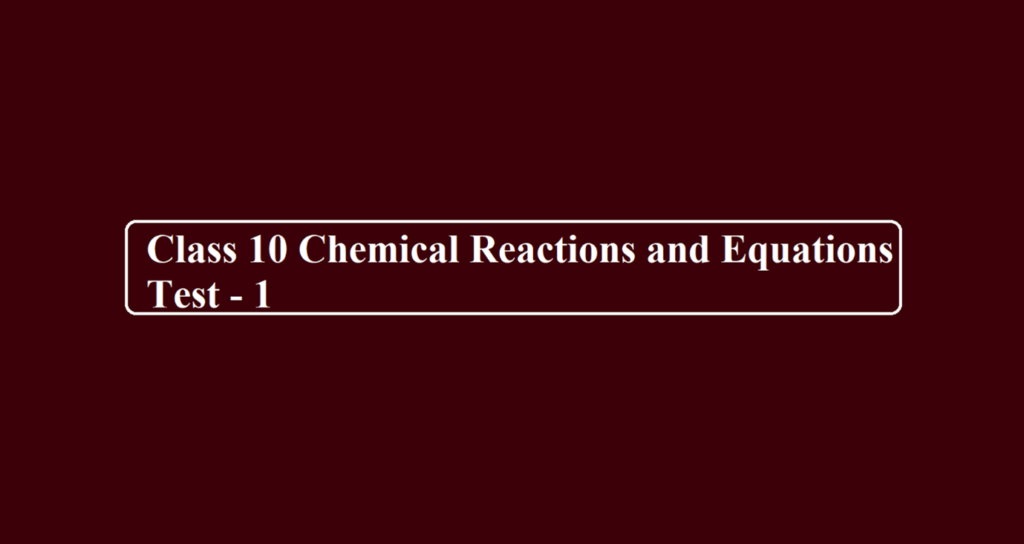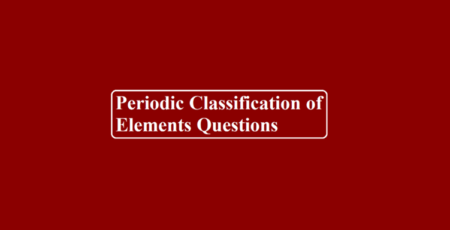Class 10 Chemical Reactions and Equations Test – 1
Class 10 Chemical Reactions and Equations
Que 1. Write a balanced chemical equation for the following (using different steps)
(i) Iron reacts with water (steam) to form the ferric oxide and liberate hydrogen gas.
(ii) When potassium chlorate (KClO3) is heated in the presence of a manganese dioxide catalyst, it decomposes to form potassium chloride and oxygen gas.
Que 2. Identify the following reaction type in which:
(i) Carbon monoxide reacts with oxygen to form carbon dioxide
(ii) Ferrous sulphate is heated strongly
Que 3. When an electric current is passed through acidified water, it decomposes to give hydrogen gas and oxygen gas. Represent the reaction involved and the type of reaction.
Que 4. What happens when silver chloride is exposed to light? Write chemical reactions also.
Que 5. What happens when barium chloride solution is added to sodium sulphate solution. Write chemical reactions and the state of the product formed.
Que 6. When hydrogen sulphide reacts with chlorine, then sulphur and hydrogen chloride is formed. Write the chemical reaction involved and identify the species reduced and oxidized.
Que 7. What is the effect of moisture on iron?
Que 8. Explain why
(i) Burning of natural gas is an exothermic process.
(ii) Respiration is an exothermic process
(iii) All the decomposition reactions are endothermic reactions
(iv) Photosynthesis is an endothermic reaction. (v) Oil and fat containing food items are flushed with nitrogen. Why?
Que 9. When a copper strip is placed in a solution of silver nitrate, copper nitrate and silver are formed. Name the reaction.
Que 10. When magnesium burns in Cl2, it forms magnesium chloride. Which element is reduced?
Que 11. Oxidation and reduction are
(A) Gain of electrons and loss of electrons
(B) Gain of electrons & loss of electrons respectively
(C) Loss of electrons & gain of electrons respectively
(D) Loss of electrons & loss of electrons
Que 12. Copper objects lose their lustre or shine after some time. The surface of these objects acquires a green coating of basic copper carbonate CuCO3.Cu(OH)2 which is called rust of copper. This is due to
(A) Attack of H2O (vapour) and CO2 present in the atmosphere on the surface of copper
(B) Attack of H2O & O2 present in the atmosphere on the surface of copper
(C) Attack of H2O, O2 & CO2 present in the atmosphere on the surface of copper
(D) None of these
Que 13. In the reaction PbO + C ® Pb + CO
(A) PbO is oxidised
(B) C acts as an oxidising agent
(C) C acts as a reducing agent.
(D) This reaction does not represent a redox reaction.
Que 14. Ferric oxide reacts with aluminium metal upon heating to form aluminium oxide
and iron. In this reaction, Fe2O3 acts
(A) Reducing agent
(B) Oxidizing agent
(C) Both oxidizing and reducing agent
(D) Above reaction is not a redox reaction
Que 15. According to the electronic concept
(A) Oxidation is the gain of electron
(B) Electron donating species is called an oxidising agent
(C) Reduction is the gain of electron
(D) Electron accepting species is called reducing agent
Que 16. Generally, packing of fat and oil contain food is done by adding N2 gas to it.
It is because ___
(A) Nitrogen is too reactive
(B) Nitrogen is unreactive gas and there is no oxygen in the air to cause its oxidation
(C) Nitrogen has very good taste
(D) Nitrogen has a very good odour
Que 17. The reactions in which the energy needed in bond breaking in the reactant is less than the energy released when new bonds are formed resulting in products that are
(A) Exothermic reaction
(B) Endothermic reaction
(C) Data insufficient
(D) Redox reaction
Que 18. When iron nails are put in a solution of CuSO4,
(A) Copper metal is displaced
(B) The blue colour turns light green
(C) The copper metal is deposited on the iron ails
(D) All the above
Que 19. During the reaction of Zn with H2SO4
(A) Zn loses electrons
(B) Zn gain electrons
(C) Zn get reduced
(D) Both (b) and (c)
Que 20. CaCO3 (s) + Heat ® CaO (s) + CO2 (g), this reaction is
(A) An endothermic reaction
(B) An exothermic reaction
(C) A reaction that is neither endothermic nor exothermic
(D) A reaction in which a catalyst is used.
Que 21. Consider the reaction
A + B → C + D + Heat this is example of
(A) Reversible reaction
(B) Endothermic reaction
(C) Exothermic reaction
(D) All of the above
Que 22. A reducing agent is a substance which can?
(A) Donate proton
(B) Accept electron
(C) donate electron
(D) accept proton
Que 23. A brown mass of ferric chloride is formed on the iron surface as a result of a combination reaction between iron and chlorine, in this process
(A) Iron gets oxidised
(B) Iron gets reduced
(C) Iron gets oxidised as well as reduced
(D) It is not a redox process
Que 24. Identify a, b, c, & d in following reaction?
a AlCl3 + b Ca (OH)3 → c Al (OH)3 + d CaCl2
(A) a = 2 b = 1 c = 3 d = 4
(B) a = 2 b = 3 c = 2 d = 3
(C) a = 3 b = 3 c = 3 d = 3
(D) a = 3 b = 1 c = 3 d = 2
Que 25. During combustion of methane gas
(A) Methane gets reduced
(B) Oxygen gas gets reduced
(C) Methane gas acts as an oxidising agent
(D) Both (A) and (B)
Class 10 Chemical Reactions and Equations
(Answers) Class 10 Chemical Reactions and Equations Test – 1



